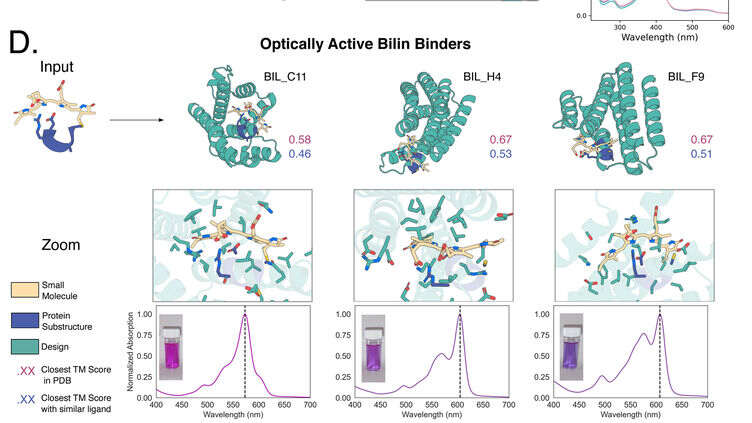Breakthrough in photosynthesis research: Deep learning applied to protein design

De novo Designed Bilin-Binding Proteins
In a groundbreaking study, researchers at the University of Washington in Seattle have achieved a breakthrough in protein design using a novel deep learning method called RoseTTAFold All-Atom (RFAA). This cutting-edge technique has opened up new possibilities for predicting and designing complexes of proteins, small molecules, and nucleic acids. By utilizing both deep learning and supercomputing power, scientists are now able to create proteins from scratch that can bind a wide range of cofactors and substrates, revolutionizing the field of protein design.
Led by renowned scientist Professor David Baker, the team at the University of Washington developed an additional tool, RFdiffusionAA, which enables the construction of protein structures around small molecules. This transformative advancement has paved the way for designing proteins that can effectively bind and interact with various types of small molecules, a crucial area of interest for many researchers in the scientific community.
The quest to find a suitable candidate small molecule to evaluate the effectiveness of RFdiffusionAA led Professor Neil Hunter at the University of Sheffield in the UK to propose bilins. Bilins are colorless and featureless compounds until they are securely bound within a defined binding site, at which point they become vibrantly colored and visibly emissive. Professor Hunter had previously worked with former PhD student Sam Barnett to create E. coli strains capable of synthesizing bilins, and they had successfully developed a native bilin-binding protein called CpcA.
To validate the efficiency of RFdiffusionAA, current Ph.D. student Felix Morey-Burrows from the Hunter/Hitchcock research group at Sheffield devised a multiwell assay that could rapidly screen a multitude of RFdiffusionAA-generated genes in parallel. By using E. coli cells capable of producing phycoerythrobilin (PEB), Morey-Burrows evaluated 94 designs simultaneously, leading to the identification of nine proteins that displayed pigmentation or fluorescence and were dissimilar to any known native bilin binders.
This crucial experiment not only confirmed the effectiveness of RFdiffusionAA but also demonstrated the immense potential of this method in modeling complex protein-small molecule interactions. These findings have far-reaching implications, particularly in the field of multicomponent biomolecular assemblies, where alternative methods are scarce. Additionally, this breakthrough could enable the design of small molecule binding proteins and sensors, expanding the horizons of biochemical research.
The remarkable aspect of this study lies in its implications for photosynthesis research. The ability to tailor the spectral profiles of designed biliproteins by manipulating the conformational flexibility of the bilin and the protein microenvironment opens up a world of possibilities. With just one round of design using a single chromophore, the researchers successfully covered the 34/30 nm range in absorption/emission. This advancement raises exciting prospects for developing de novo-designed antenna complexes that can harvest light across a wider range of the UV-visible spectrum, thereby enhancing photosynthetic energy capture and conversion. Furthermore, these findings offer the potential for creating fluorescent reporter probes with customizable excitation/emission maxima, valuable tools in biochemical research.
The use of deep learning and supercomputing has undoubtedly played a pivotal role in driving these breakthroughs in protein design. The vast computational power of modern supercomputers, such as those employed in the University of Washington's research, is fundamental to processing the large datasets required for training deep learning algorithms. Through their collaborative efforts, scientists have harnessed the potential of deep learning and supercomputing to unlock the secrets of protein design, propelling us into a new era of scientific discovery.
As researchers continue to explore the applications of deep learning and supercomputing in various fields, we can anticipate more paradigm-shifting developments and remarkable discoveries that will reshape our understanding of the natural world.

 How to resolve AdBlock issue?
How to resolve AdBlock issue?